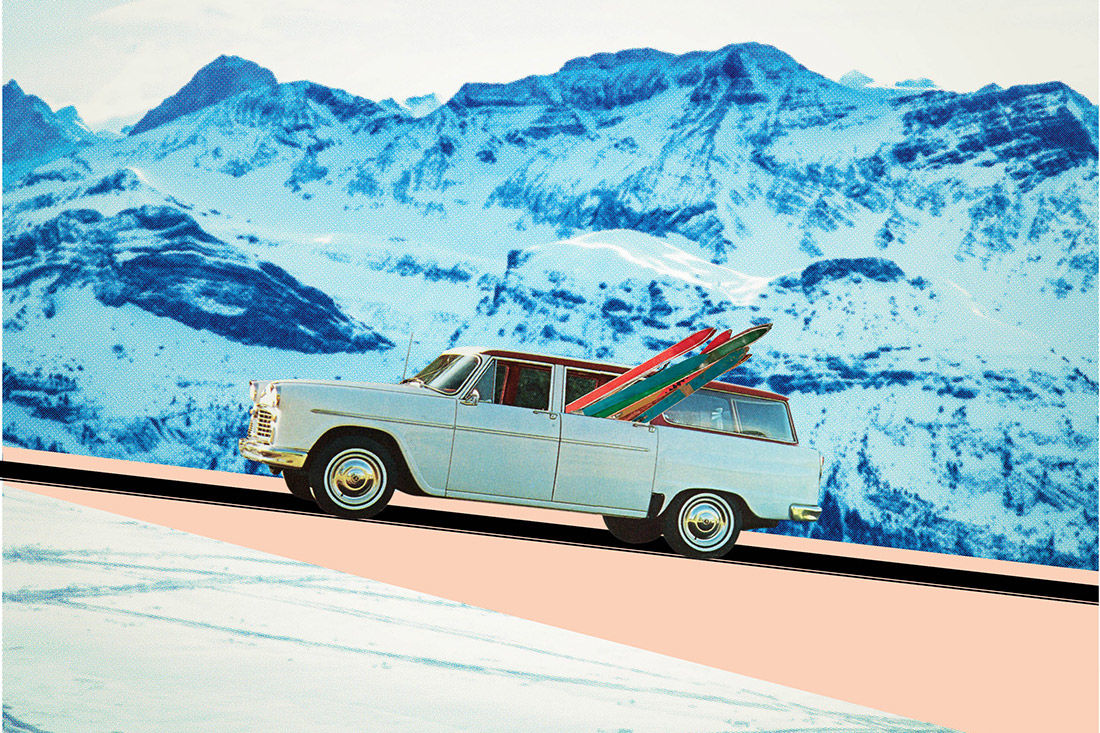
Three Bum Tour
Each time we hit the foothills, there was a mandatory bathroom pit stop. By then the sun was up, my sister and I were awake in the back seat of the Checker Marathon station wagon, and snow was visible on the eastern peaks. Sure signs of another ski road trip.
I grew up skiing in the Sierras with my family. We lived in the suburbs of San Francisco and drove up to Tahoe—sometimes a four-hour trek—on as many Saturdays as we could fit into a ski season, plus one full week that we looked forward to each year. My folks, who owned a small business and were going local before it was fashionable, sought out the family-run resorts, of which there were still many in the 1970s. Our go-to spots were Homewood, Tahoe Ski Bowl, and Alpine Meadows, where I first learned to ski.
My resourceful parents met at the Sun Valley Lodge in 1966, where she waited tables and he bussed them. In return, they received five bucks a day, room and board, and a season pass for which they had to supply seventy-five cents to cover printing. It was just one season, but that was enough to instill in my parents the ski-bum ethos forever: get the most outdoor fun out of the least dime. Once we came along, Mom and Dad sourced affordable lift tickets, threw a picnic lunch in the rucksack, and made sure we were first on the lifts and last off, no matter how far away the mountain was.
I don’t pretend to be a ski bum today, even though I was in my twenties when I followed my parents’ tracks to Ketchum and later broke trail to Aspen. But memories of those childhood trips—the predawn departures when my sister and I would slumber on either side of a box of warm doughnuts—remained lodged in my suburban dreams. They were about as close as I would get to the well-worn dirtbag tradition of sleeping in the resort parking lot.
Fast forward to the past couple of years and, to paraphrase John Muir, other mountains called. But two practical matters kept me rooted—and at times longing—here in Aspen: November’s big-ticket item (my season pass) and free lodging (our home). Then the Aspen Skiing Company debuted the Mountain Collective pass [see “The Ski World’s Ultimate Mixtape” below]. Suddenly, and for less than a set of decent snow tires, I could get twelve days at eight of the West’s legendary hills. With this irresistible deal, road tripping to other mountains seemed possible—if we did it ski-bum style.
Ascending Squaw Valley’s Funitel on the first day of our tour, I felt the irrepressible excitement that kids in candy stores everywhere know: which one to try first? During my seventeen years in Aspen, I had taken for granted the local intel that accumulates when one pursues the same mountains season after season. Minor panic set in as I realized I had no idea where to point my boards across Squaw’s 3,600 skiable acres. Then I remembered free beta available for the asking, from the most knowledgeable guides on any mountain—the patrol.
They sent us to Granite Chief, a snowy hammock strung between two circa-9,000-foot peaks on Squaw’s backside. The off-piste snow was still starched when we arrived, but with temperatures that would eventually climb to fifty-seven degrees, the “spring snow” (what goes by “corn snow” in Colorado) began to go off. Soon we were sliding among buttresses, chutes, and mogul fields, surfing springtime slopes. Back home, a day like this would have had the locals reaching for their vintage hotdogger attire, or at the very least an aloha shirt and a tutu. Here, bikinis and bare man chests ruled the day, and the California exuberance was contagious. Despite Squaw’s distracting sponsor logos displayed at every turn, this was Mother Nature’s amusement park, and I could have kept playing in it all day. That was not to be. We quickly ran up against the sleep-in-your-vehicle limits of our ski-bum plan. Sure, we had upgraded from a car to a seventeen-foot winterized travel trailer (named, of all things, Bigfoot). But to make the designed-for-two space work for our three travelers, my adolescent son had to sleep in a makeshift bed on the floor, where the first night he got very few winks. Our normally puppy-of-a-guy ran out of steam early. So it was that on day one, at 1:30 p.m., before the slush even had a chance to close us out, we were shut down, our trip trending more bum than ski.
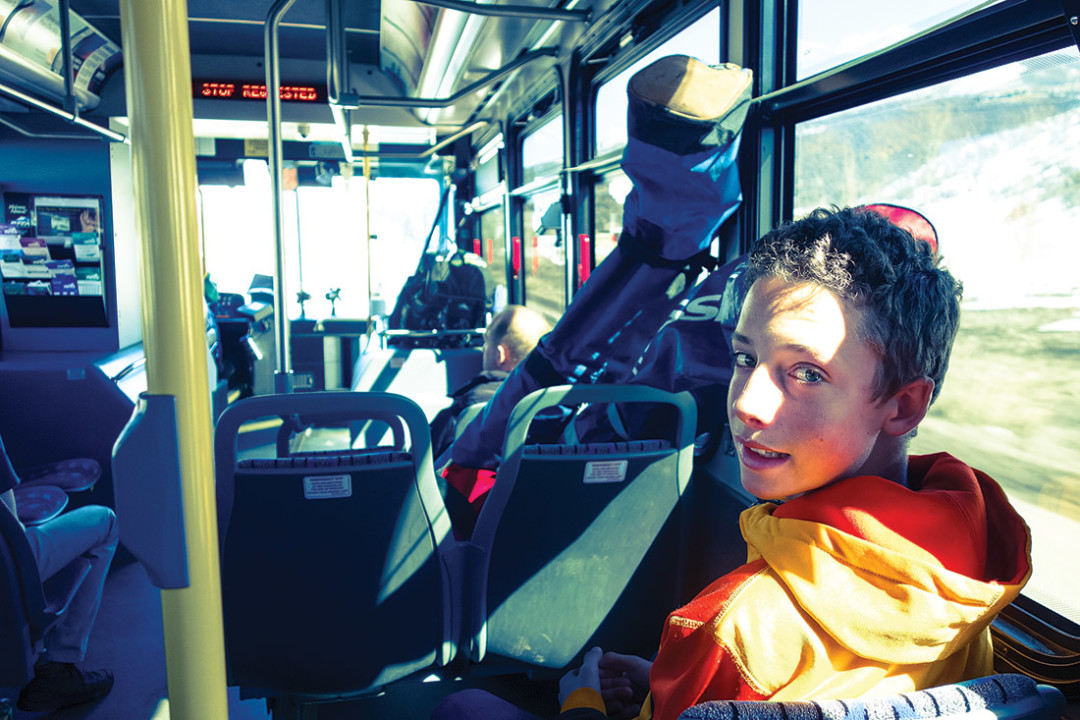
It hadn’t been hard to find takers for the journey: a six-state tour of the West, hitting as many Mountain Collective slopes as we could in two weeks. My dad, Tom, who at seventy-one still charges any hill he can get to, was a natural choice of comrades. Appearances to the contrary, I knew he wasn’t getting any younger. And my twelve-year-old son, Colt, certainly was getting older fast. I imagined a small window when everyone in this crew could hang together on the double-black-diamond runs. If anything, I, an enthusiastic but middling skier up until I got schooled on Aspen’s slopes in the Aughts, was the weak link. After making some adjustments to our sleeping quarters and getting into the groove of breakfast in bed (there really is no choice in a trailer-built-for-two), we readied ourselves for Squaw’s sister resort, Alpine Meadows.
The two mountains, which were developed independent of one another in 1949 and 1961, have been co-owned for the past four years by a single corporate entity. Thankfully, they each have retained their own flavor. To Squaw’s welcoming-but-slick corporate ambiance—Hello, world’s first ski-in/ski-out Starbucks!—Alpine counters with a mellow, rough-around-the-edges vibe, reminiscent of old Aspen Highlands. A laid-back staff, dread-headed snow riders, and a onesie-clad, boom-box-wearing celebrant whom the ski patrol called the “King of Fun” were our company for the day.
Fun is certainly what comes to mind when I think back to my father introducing me to the chairlift at Alpine four decades earlier. After a wearying morning in ski school, where four-year-old initiates like me would make Sisyphean laps—lumbering on foot up a small hummock and plowing down the other side through the legs of a plywood cutout of Snoopy—I wasn’t so keen on this skiing thing. Finding me in tears at the end of the session, Dad decided that there was still fun to be had. He loaded me onto the chair, where, to hear him tell it, I quickly grasped the concept of “lift” and never looked back.
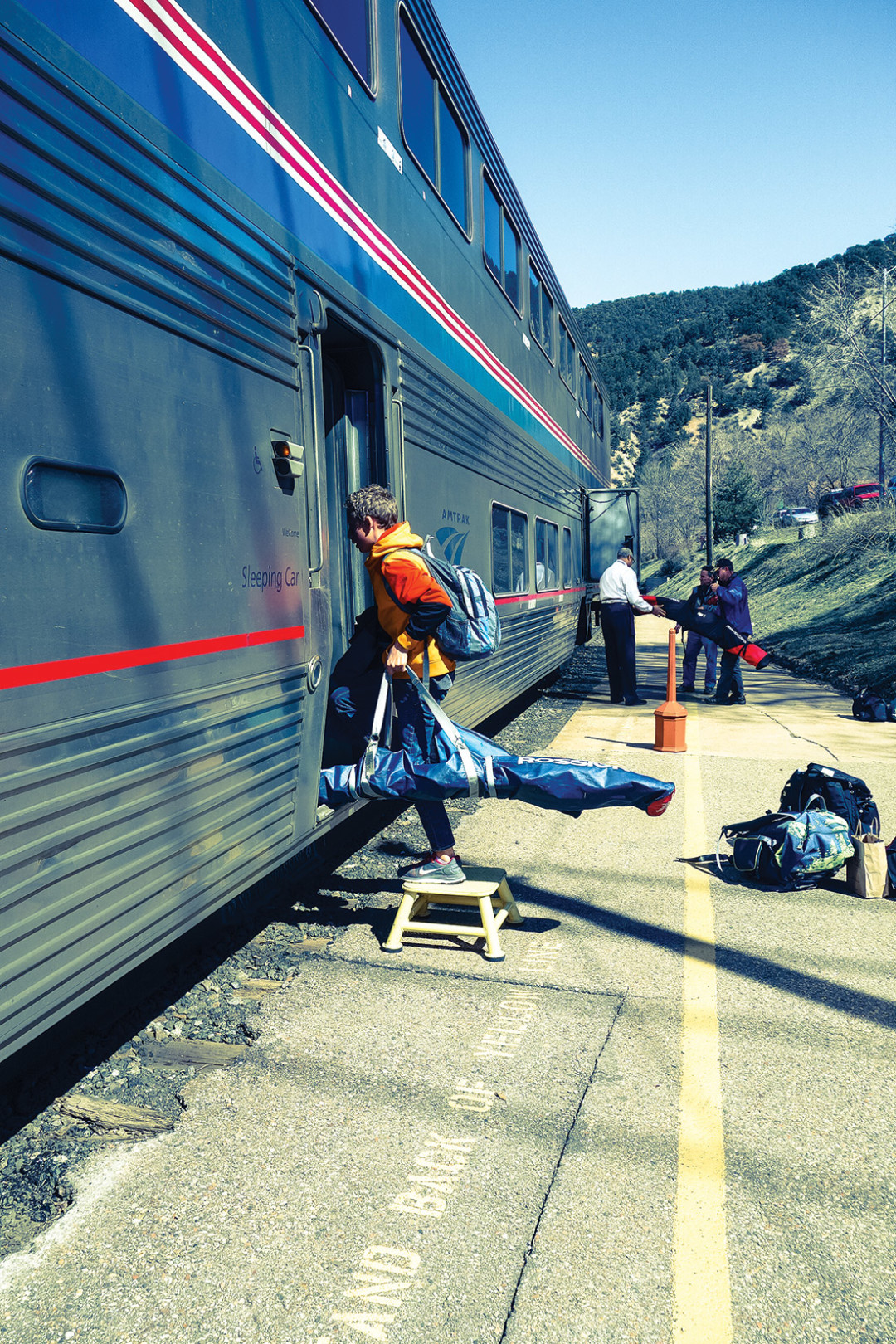
On this day, the view from Alpine’s chair still had the power to seduce. But the conditions our liftie had euphemistically cautioned as “firm” we soon found to be groomed ice and wind-scoured crust, in spots raked over bare ground. Unwilling to skitter over frozen sheets of yesterday’s corn snow, we decided to go higher.
From above, we spied a queue of skierants scribing a line just under the 8,637-foot Ward Peak and then dropping out of sight. Boards slung over their shoulders, these hikers had the body language of locals. Though usually one to prefer the so-called safety of the known world, I was just frustrated enough with the miserable options below to lobby my compatriots for the unknown that lay beyond.
My instincts, abetted by directions from a topside lift operator, proved spot on. Once over the Upper Saddle and with Lake Tahoe in our sights, we plunged into wide-open bowls of what I would later learn was a particular Tahoe delicacy: perfect corn snow. All we knew was that it was the creamiest stuff on the planet, and we made as many laps as we could until the softening snow wouldn’t hold our weight any longer.
“The roles have reversed,” said my dad. “You’re talking me into things now.” He didn’t look displeased.
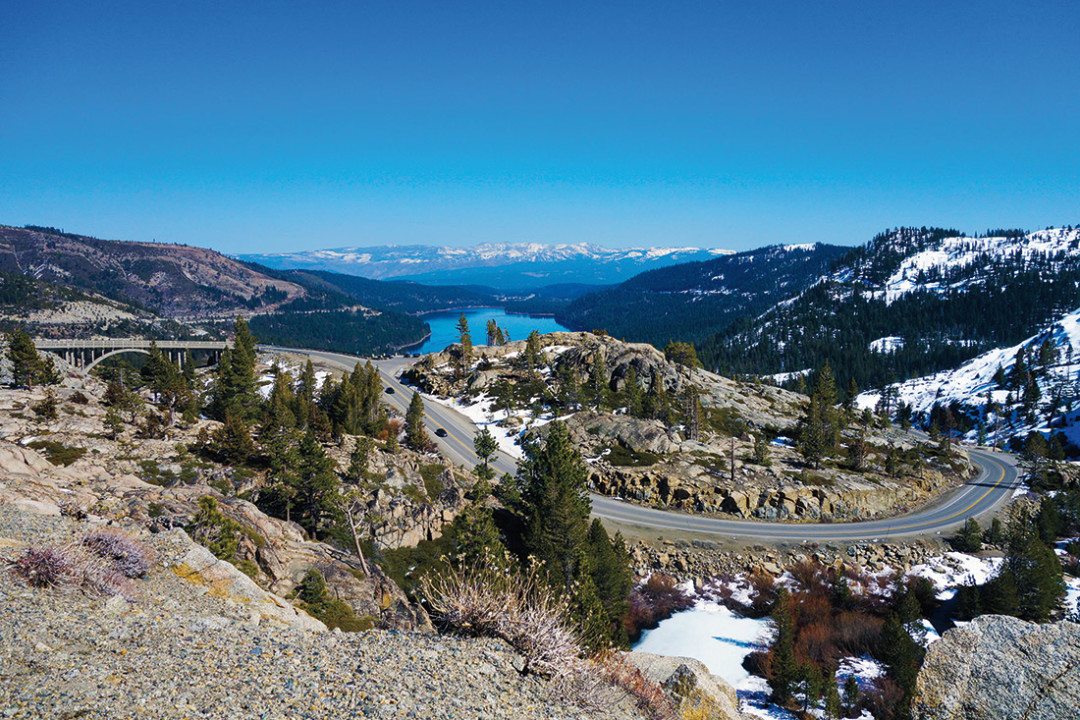
Colt and I had rolled into Truckee, a hamlet of 16,000 that serves as Squaw and Alpine’s remote ski town, via Amtrak’s California Zephyr, on the same transcontinental rail lines that made the settlement’s early fortunes as a transportation hub. Truckee remains a gateway to the Sierra—and a bonafide town in a region filled with Vail-like villages contrived to serve at the feet of Tahoe’s many resorts. I don’t know if it was my California roots finding purchase or the enticing hippie/gold miner/backcountry vibe or the fact that Truckee, like Aspen, had a story all its own before it grew into a ski destination, but this place felt a lot like home.
In search of happy-hour-as-dinner (a key to maintaining our economizer budget), we stumbled into Truckee’s Cottonwood Restaurant. Photo-studded walls revealed the eatery’s past life as a ski-area warming hut, which featured a toboggan flume, 140-foot ski jump, and the nation’s first mechanized lift when it opened in 1928. The sepia images also tickled my dad’s memory, prompting recollections of my grandfather, an athletic Dane by the name of Harry Petersen, who had been among the thousands of Bay Area skiers who ventured up to the slopes via Southern Pacific’s “excursion train.” The rail cars were parked on the side of the tracks in Truckee, providing weekend accommodations for their hearty passengers. I was beginning to wonder if sleeping in the rig was genetic.
To survive a winter in a ski town, as any local knows, you have to be a Zen meteorologist, adopting an expert’s knowledge of the weather and a yogi’s proclivity for letting go of it. Mother Nature drops in when and where she sees fit. And so it was in Mammoth, which would reap a mere 31 percent of average snow pack by season’s end and where we encountered the full deficit of California’s historic drought. A decade earlier, John Muir had noted that the southern Sierra, notorious for its capacious dumps, “seemed not clothed with light but wholly composed of it, like the wall of some celestial city.” One hundred years had done nothing to dull this dazzling vision, but in Mammoth we found mere remnants of snow. It didn’t bode well: our mission was skiing, not poetry.
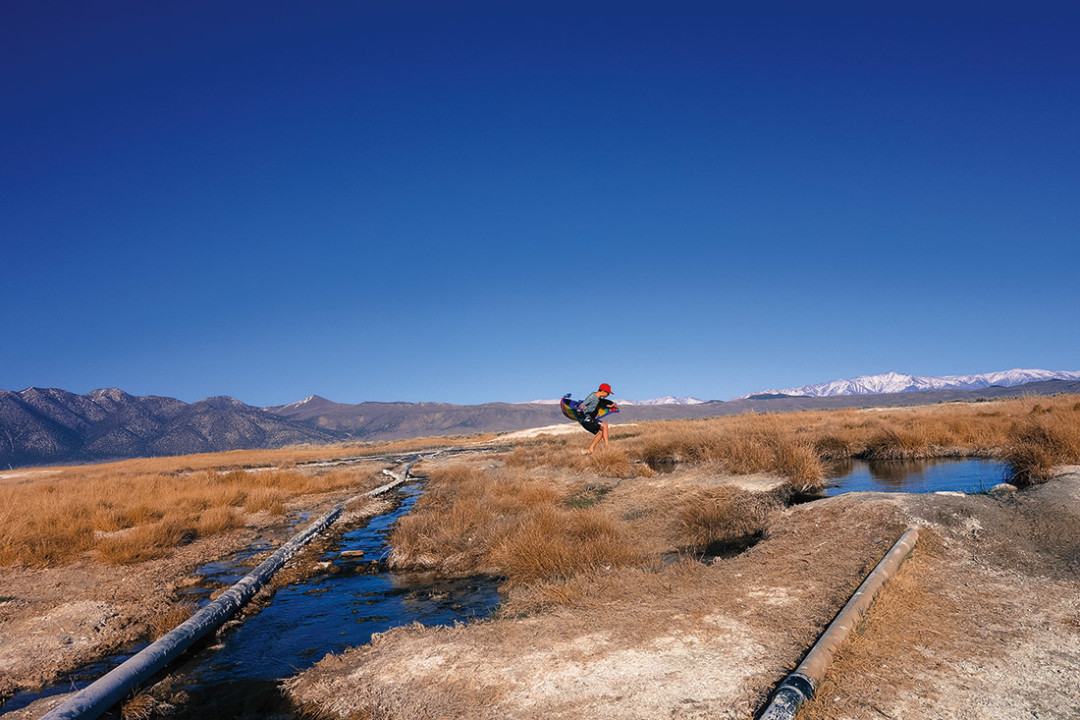
So we did what any self-respecting local would do in the face of a dismal snow harvest: we skipped the charmless town (Mammoth is no Truckee) and went to the hot springs. Mammoth’s nearby “smoking waters” are as legendary as its peaks. The natural hot creek area, on the eastern plain, is considered to be the mother lode of the state’s many geothermal flows. The pools’ spirited names—Crab Cooker, Wild Willy’s, and Hilltop—were appropriate, given the characters we met while soaking in them: a pair of inked-up moms toasting their coincidental divorce dates, a corpulent married couple from Bakersfield on a hot springs road junket, two rock climbers day-tripping from Bishop, and a club kid with a stereo speaker the size of a clothes hamper. Every last one of them embraced the clothing optional mantra. Colt employed two survival mechanisms to enjoy his soak: avert your eyes, and insist that your mom and grandpa keep their shorts on.
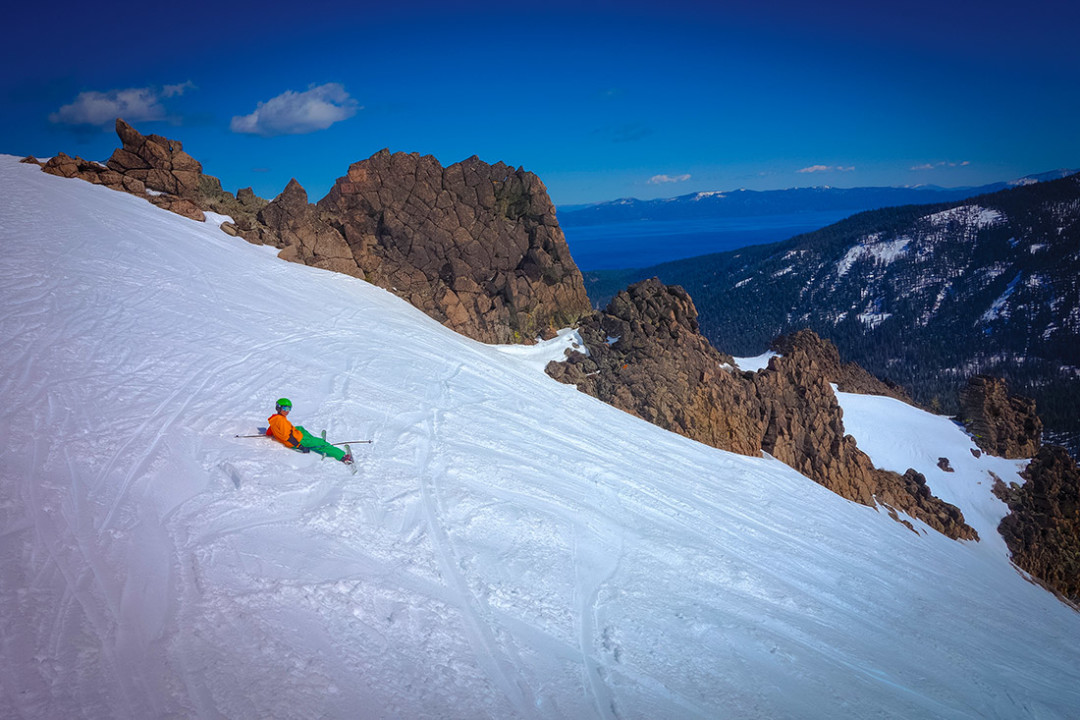
Driving from Mammoth to Salt Lake’s Little Cottonwood Canyon was a huge, three-state pendulum. The nine-hour drive took us eleven towing Bigfoot. Thankfully, snow—and Snowbird—awaited us. My nephew had flown in the night before with his snowboard, scratching Alta, a skiers-only holdout, from our Mountain Collective punch list.
The Ski World’s Ultimate Mixtape
When the Aspen Skiing Company debuted the Mountain Collective Pass for the 2012–13 ski season, big-mountain skiers took note. For $359, the pass offered two days of skiing at each of Aspen/Snowmass, Jackson Hole, Alta/Snowbird, and Squaw Valley/Alpine Meadows—some of the best ski areas in North America—plus half-price tickets at any of the resorts once its free days had been used.
The Mountain Collective added Mammoth and Whistler/Blackcomb for the 2013–14 ski season (the season of this article’s “Three Bum Tour”). Ski Banff/Lake Louise/Sunshine Village joined the list for 2014–15. In March of 2014, SkiCo offered a spring incentive of two days at each of Thredbo Alpine Village in Australia and Chile’s Valle Nevado, plus a third day of the purchaser’s choice at any of the Mountain Collective ski areas.
The 2014–15 pass, which also included discounted lodging at each ski area, went on sale in March 2014 for $359, was unavailable during the summer, went back on sale for $389 in mid-August, and was selling for $409 when the sales window closed in January 2015. A pass for skiers under the age of thirteen, with the same benefits as the adult version, sold for $99.
Prices have not been set for the 2015–16 season, but SkiCo says the pass’s terms and sales windows will likely be similar to last year’s, with a springtime purchase offering the best deal.
Pulling up at the parking lot, I felt like an out-of-town surfer being high-fived by friendly locals at an awesome wave. After parking for free in the slope-side VIP lot (a courtesy extended to carpools of four or more), we were whisked to the top of the 11,000-foot hardly “Hidden” Peak in eight minutes. On a bluebird day that would top out at thirty-nine degrees, we ditched our California bathing suits and chased the sun, pirouetting between winter and spring conditions in the resort’s upper cirques. As we plied the bowls served by the Mineral Basin, Little Cloud, and Gad 2 chairs, layers of the mountain kept revealing themselves. When we wore out the basins, we ducked into the trees, where the boys whooped it up in Black Forest’s natural terrain park—think Snowmass’s unnamed gullies, multiplied by five.
The resort delivered all that day and all day the next, not just on the slopes, but in the metrics I’ve come to appreciate in Aspen: sociable staff, local characters, right-priced lockers, a happening picnic patio, and even a killer smoothie bar for PG-rated après-ski. Colt ranked it the best hill so far, and we left knowing we’d be back, thankful that Snowbird was a semi-reasonable drive from home.
As we shipped my nephew back to my sister, the weather was shifting, and we knew Bigfoot’s days as our home on the road were limited. Our plan to tow in winter had always been a roll of the dice. The sunny days that produced marginal mountain conditions in California had, admittedly, made for smooth driving. With snow coming, we parked the trailer with friends near Salt Lake, relieved to discover that Jackson Hole, our final stop on what I was now calling the Three Bum Tour, boasted a youth hostel ranked by the Guardian as one of the “five best ski hostels” in the world. Shabby, clean, and sporting both a tuning room and a one-minute walk to the gondola (in ski boots, no less), it was perfect for those who don’t need the trimmings. Which we didn’t.
The following day, we woke to gray skies and the sinking feeling that we had missed prime spring conditions by twenty-four hours. We were eager for what everyone had told us was this season’s best snow in the West. (During our visit, Jackson Hole was days away from hitting its 400th inch of snowfall.) But a cold front had moved in overnight, transforming the resort’s storied terrain—ranked no. 1 for variety and challenge by Ski Magazine—into an unappetizing stew of flat light and frozen ruts. We convinced ourselves it would be different up top, until an early bird slunk past, muttering about having skied just one run. Code for: pick another day. Which we did.
That said, we hadn’t come this far to jettison our boards. Unearthing the cross-country skis, packed for just this eventuality, we headed north to the boundary of Yellowstone National Park and to rumors of a ski-in hot spring, our plan B. We would get lost and found again trying to find our way to the elusive Huckleberry Springs. It was just the right therapeutic adventure to soak away the inhospitable weather, even if a Park Service sign warned of the presence of a heat-loving amoeba that carried meningoencephalitis, a “rare but fatal” disease that invades the nasal passages en route to the brain. The ski-bum life must have been loosening me up. Dad and I jumped in, figuring we would simply avoid that outcome by keeping our heads above the water. Now Colt names the eight-syllable microbe every time he thinks I am making a suspect decision.
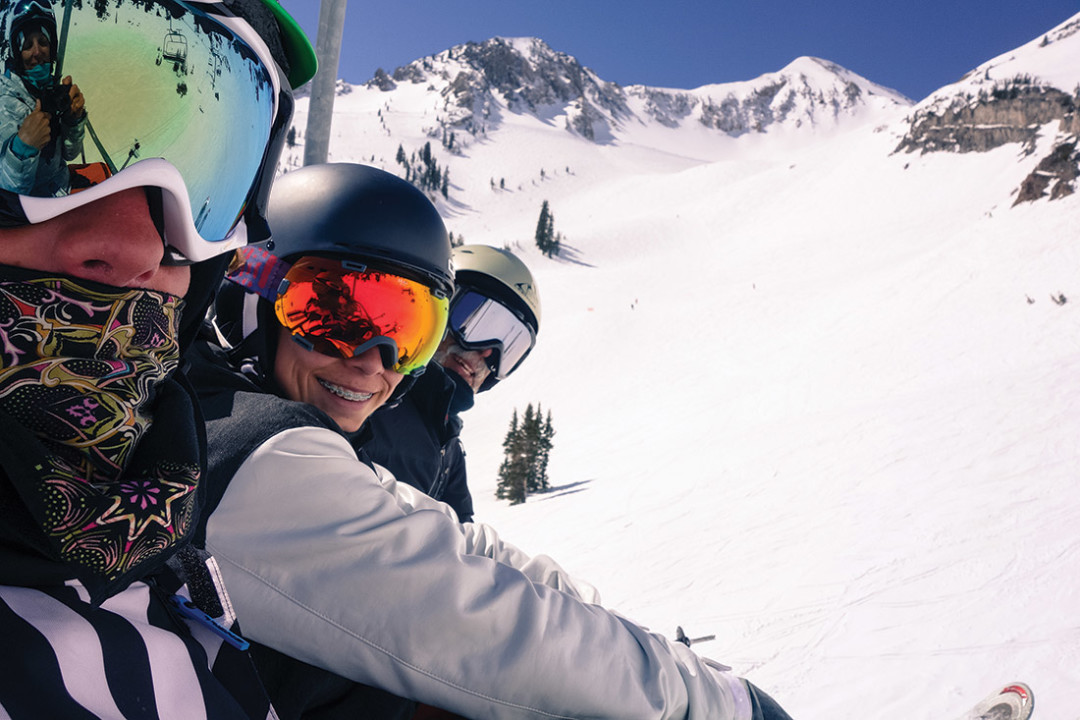
The next morning had us on an early ride up Jackson’s tram, even though the conditions were arguably worse than the day before. I recognized the antsy, testosterone energy at the base of Jackson from the line at the Aspen gondola on any given powder day. This buzz, which could provide a jittery uplift of suspense at home, felt intimidating far from my familiar slopes. Once again, I wondered if I was going to be able to find the goods, a tall order at 10,000 feet in a whiteout with local guns blazing past me. So Colt and I decided to regroup in an alternate world of powder. At the mountaintop Corbet’s Cabin, we dove into fresh griddled waffles, topped with lemon curd, whipped cream, and powdered sugar. In the end, with no locals in sight, we trusted our instincts and found what we were seeking.
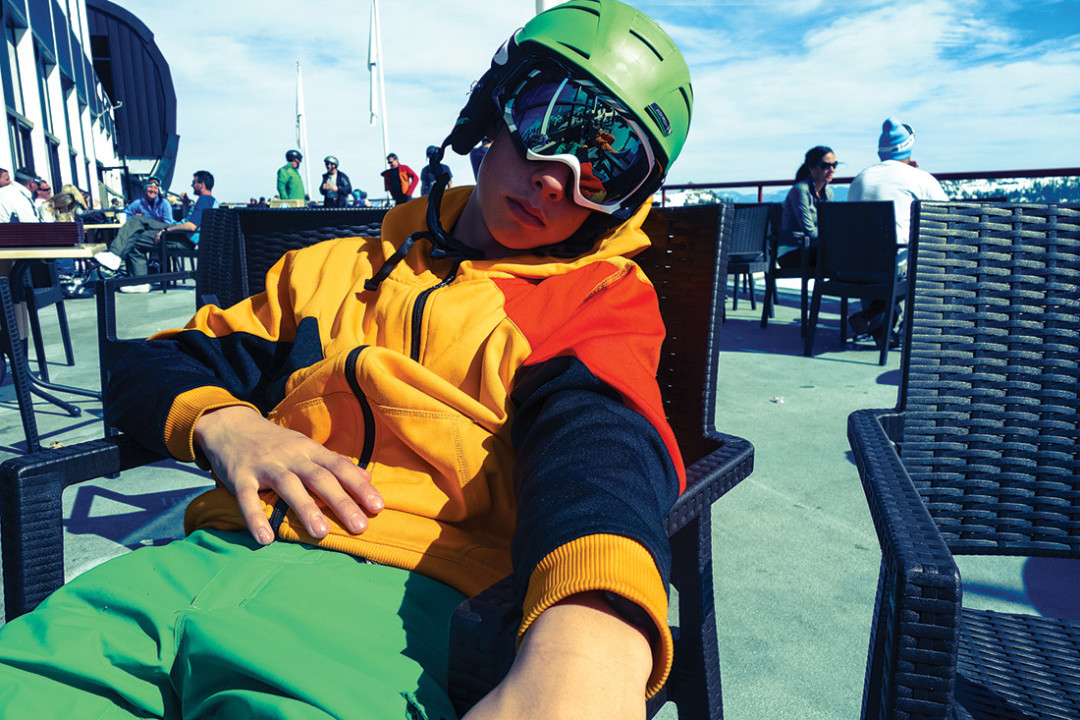
My dad? He just pointed his skis down the mountain. In his eighth decade, and living the farthest of any of our clan from the slopes, he is the hungriest of us all. He loves to ski—always has—and will go for it in conditions that I find marginal at best. Ski town locals have the luxury of picking our days, and we do. But my dad still wrings every inch of vertical out of every day, charging the mountains as he showed me how to so many years ago.
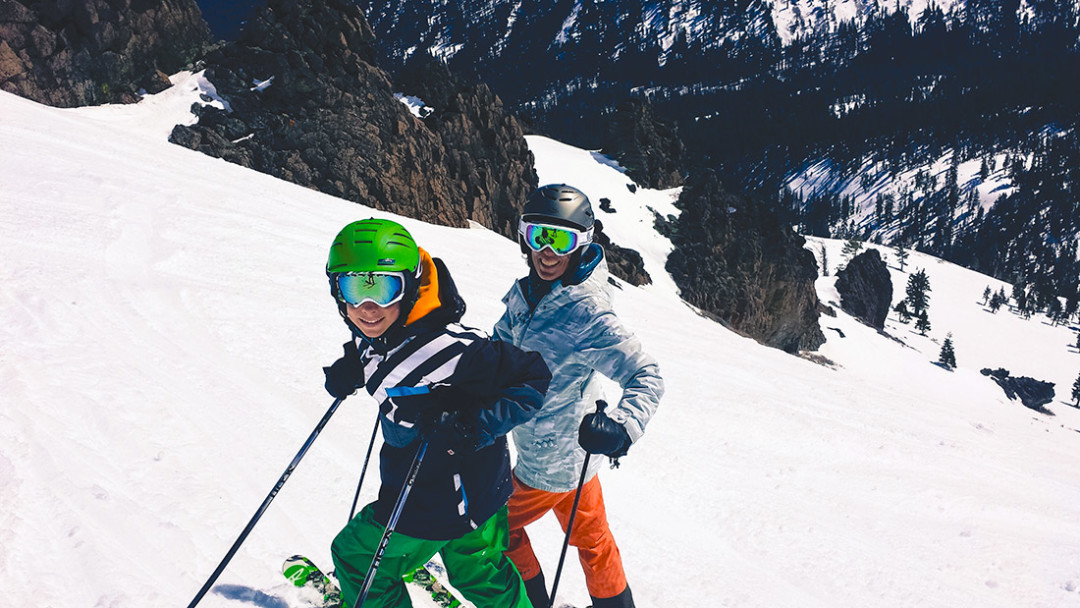
Postscript: Our adventure was born, as so many are, with an idea to catch a fleeting moment before it’s gone. Of all the things I had hoped to discover on the road, none was less expected than falling in love with my home mountains all over again.
Sometimes you have to leave home to remind yourself why you came here (or came back) in the first place. Sure, Jackson’s got the rugged terrain and bad-boy edge. Snowbird, devoid of an actual ski town, still rocks an authentic mountain culture. The populist/bohemian vibe of Truckee and the inspiring freestyle territory of Squaw and Alpine make Tahoe a contender. And I would go back to surf Mammoth’s geothermal tide any day, assuming there was snow. But no place gets as much of it right as much of the time as Aspen. My adopted hometown’s allures are even enough to make me overlook her aggravations, like the ubiquitous handbag stores, the high rollers trying to turn Aspen into a members-only club, and the increasingly bad odds of getting an unannoying gondola ride.
Aspen’s ski town credentials were right below my nose the whole time: a “four-fer” of mountains; Lift 1A on a powder day; Highland Bowl and all the other earn-your-turns terrain; Colorado pow; genuine environmental leadership; yoga at the Sundeck, cannabusinesses in town, and local beef in the burgers; lifts whose safety I never question; footrests on just about every chair (I never knew how important they were until I didn’t have them); on-mountain ambassadors doling out free cider, sunblock, and sometimes even cookies; and a town where you don’t have to put your stuff in lockers any more than you have to lock the doors to your house, because it’s a pretty darned safe place to hang.
And did I mention the beehive of culture at the foot of the mountain? In what other ski town can you pop out of your bindings and into two daily newspapers, a public radio station, a cinema, an independent bookstore, and dozens of art galleries and cultural nonprofits?
Sometimes Aspen’s native charms get obscured by the weight of so much finery, and it becomes easy to take them for granted, as I had begun to. But simple pleasures need no padding, just fresh eyes. A slow ride on the Bell Chair—with birdsong signaling spring—and knowing the precise coordinates for the sweetest corn snow is all it takes to be reminded: it’s Aspen’s mountains that are calling, not the trimmings.














































